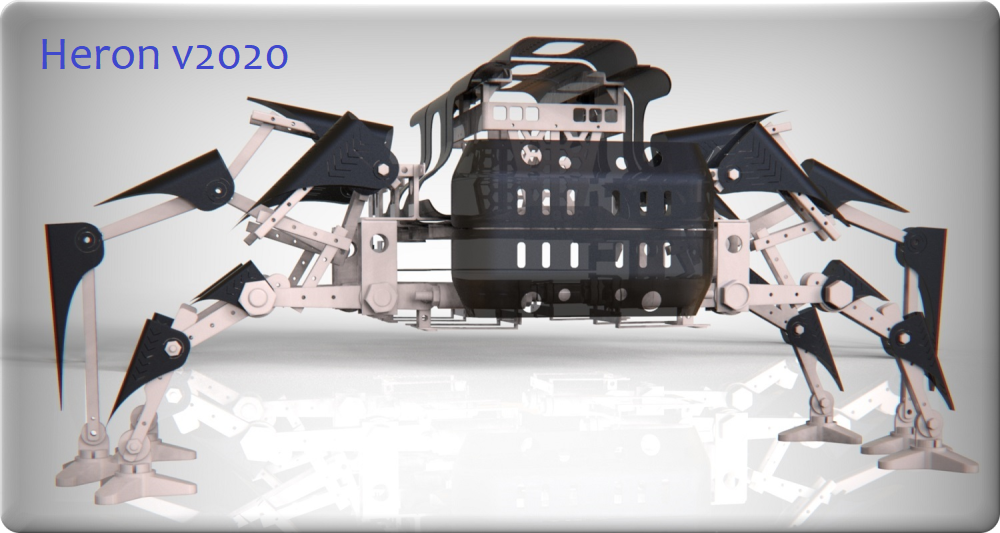ES Design
Heron Robot
"In the emerging scenarios of the 21st century,
waterfronts, smart cities and other urban and rural human settlements
can not exist without an ecosystem of insect inspired robots like Heron v2020."
"We imagine, design and build robots "insect inspired" for the III millenium."
Joseph Caristena

Design: Joseph Caristena
>>> Animation
The new version of Heron v2020 is here !
After the long testing of the "Proof of Concept",
here comes the revolutionary 6 legged robot (and also 6 wheels) called "Heron v2020".
What is a "Proof of Concept" ?
A "Proof of Concept" is when the idea is tested to validate that it can become a product before it hits the early first stage of development.
POC comes after the ideation phase and you know what the service or product idea looks like.
Now you need to see if customers actually need it in the real world.
In other others if there is a real demand on the marketplace.
>>> ES Design
Mission
"The mission is to populate human settlements with "insect inspired" robots.
We design and build "Special Purpose Unmanned Vehicles" to carry all kind of sensors"
Joseph Caristena says
People need to collaborate with robots instead of competing with them.
There are some areas where robots can perform much better than humans.
Robots can generate numbers, do the math, remember everything, recognise patterns in data, lift heavy objects and move with precision.
Whereas humans are better at tasks that call for creativity, abstract thinking and many times stupidity, non sense and dummy things.
However, the development of urban robotics requires real-world experimentation ‘beyond the laboratory’ to develop commercial applications and address concerns about public safety.
Governments worldwide are seriously focused to become "Game Changers" and "First Movers" in the emerging marketplace of robotics and autonomous systems.
If we add the revolutionary e-mobility marketplace it is easy to understand where the billions of dollars of the investment funds are going to.
Our team is focused to boost robotics research, development and innovation to trigger a positive perception of robotics during the transition from cities to smart cities.
During this transition and trasformation our team will offer our long experience in co-thinking and design thinking
(Design Thinking is a non-linear, iterative process that teams use to understand users, challenge assumptions, redefine problems and create innovative solutions to prototype and test. It is most useful to discover unknown problems and involves five phases: Empathize, Define, Ideate, Prototype and Test)
to give technical assistance and 24/support worldwide.
Cities worldwide are becoming experimental sites (open labs) for new pocs (Proof of Concepts) of robotics and automation technologies applied across a wide variety of sectors in multiple areas of economic and social life.
Robotics and automation systems are being layered upon existing urban digital architectures, reshaping the city and citizen’s everyday experiences.
But the identity of a city itself is going beyond the definition of "Smart City".
A smart city becomes a “senseable city”, a city capable of feeling, but also sensitive and capable of responding to citizens who define the overall performance of the city.
The multidisciplinary approach through the dialogue between citizens, local communities, social change makers, decision makers, designers, architects, engineers and urban planners will allow to face the new emerging challenges of this "Digital Shift" and "Digital Transformation".
Smart cities will be continously shaped by the dynamics of robot integration in the urban landscape.
The cities of the future, in fact, will be pervaded by autonomous driving vehicles, robotized delivery systems and light transport solutions, in response to the new concept of smart e-mobility, on a human scale, shared and connected mobility in order to improve management and control of the digitized smart city.
Today the “Fourth Industrial Revolution” is marked by technological breakthroughs across; robotics, artificial intelligence (AI), nanotechnology, quantum computing, biotechnologies, the Internet of Things (IoT), 3D printing and autonomous vehicles.
Collectively these developments are delivering a “Cambrian Explosion” in automation and robotics, producing technologies with diverse applications, are networked, and work closely with people.
Everything and everyone has become so connected that Wifi often fails to meet our 24/7 digital needs, online orders don’t arrive fast enough, traffic congestion is still blocking the roads and environmental pollution is still one of the main problem in cities.
Indeed, there is already talk of an Industry 5.0 focussed on “combining human beings’ creativity and craftsmanship with the speed, productivity and consistency of robots”
Our team is focused on the importance of robotics and artificial intelligence inside of the new urban contexts in which it is possible to consider and enhance the different dimensions of quality of life such as safety and health, environmental quality, social connection and civic participation and engagement.
>>> Heron Community for Mass Robotics
We also launched a special "Heron Community for Mass Robotics" programme to engage people and local communities in the new emerging scenario of robots.
The fourth industrial revolution of robotic and automation technologies (4IR) is moving from science fiction and R&D to reality.
Enabled by vast increases in computing capacity (high performance computers based on petaflops and quantum computing), data harvested through powerful algorithms embedded in digital platforms, urban connectivity interfaces and digital architectures.
The emerging presence of robotics, IoT devices, automated digital driven decisions based on AI, will uniquely (re)shape continously the identity of a city and affect of the urban context along the whole value chain of public utilities and services.
Author: Joseph Caristena

BabaCad is a 3D Robot design software with a module to embed Python scripts and coding.
Software 3D for Robotics
https://www.babacad.com/Robotics/
